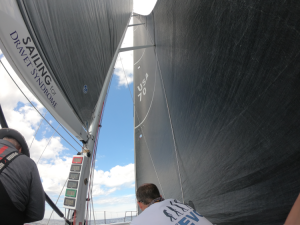What do you need to measure to order a new headsail? Are the sails that your boat currently has suitable only for a specific type of sailing? How do you know which headsails should be included in the sailboat’s inventory? Knowing the key measurements for a headsail will help you make sure a new headsail will fit your sailboat properly.
New Headsail Dimensions Needed To Get A Quote
General dimensions of a headsail include Luff Length, Foot Length, and Leech Length.
- Luff length is the distance between the head point and the tack point.
- Leech length is the distance between the head point and the clew point.
- Foot length is the distance between the clew point and the tack point.
These measurements, which you can take from an existing sail, will be sufficient to order a new one. However, you also need to be able to calculate the size of your headsail if you want to deeply understand and optimize your sailing.
Dimensions Needed to Calculate the Size of a Headsail
Two dimensions are needed to calculate the size of a headsail that is suitable for your boat:
- The “J” dimension. This is the distance from the mast to the bottom of the forestay at the stem fitting when measured along a line perpendicular to the mast.
- “Luff Perpendicular” or “LP”. This is the distance of the headsail clew from its luff when measured upon a line perpendicular to the luff. You can simply measure the shortest path between the clew and the luff.
The size of your headsail expressed as a percentage is LP divided by J.
Knowing the sail size is important when ordering a new one. If you are happy with the size that you previously had and the headsail’s performance, you can order the same one. You can also adjust the size to a bigger or smaller percentage depending on the sailing experience with your previous sail and prevailing weather conditions in your area.
The headsail size varies from 50 to 75% for storm and heavy weather sails to the common size of around 110% which is suitable for a wide range of wind and sea conditions, to the 135% size used by sailors who sail primarily in moderate conditions and, finally, the 150% genoa used for very light winds.
A new sailboat usually comes with a minimalist inventory of headsails. What you might add to this collection will depend very strongly on your type of sailing and on whether you sail shorthanded: an experienced and strong crew is ideal if you want to use a bigger sail. A day cruiser can get away with just two sails: a genoa and a working jib. An offshore cruiser, however, will need a wider range to sail safely. Those of us that race should also ideally have more than two headsails in their inventory.

Working jibs, that are designed for 15 – 18 knots of wind and above, are heavy-duty sails used more often than one anticipates. A working jib usually has an LP of 85-100%. Keeping an extra small jib will extend the life of the genoa and will be your insurance against complete sail failure when you are far away from home. The 130-135% is, generally, the most versatile size for cruising boats.
If You’re into Racing: Other Headsail Dimensions
The following additional measurements maybe required if you take part in races:
- Top width (HHB)
- Four widths found on the leech between head and the clew:
- ¼ width (HQW)
- ½ width (HHW)
- ¾ width (HTW)
- 7/8 width (HUV)
These are found by folding the sail to find equal distances between clew and head or between two adjacent measurement points.


